Trees and Shrubs with Orange Berries
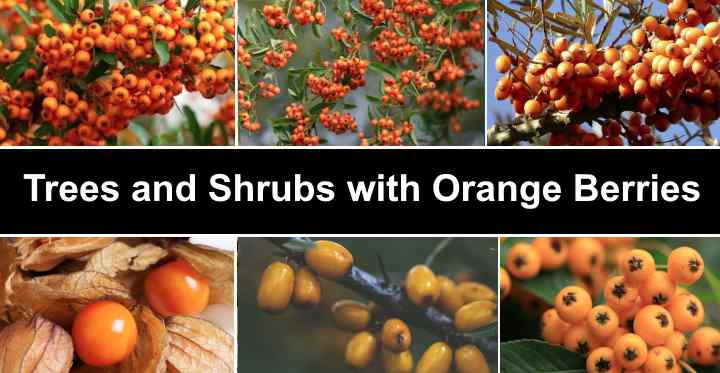
Trees and shrubs with orange berries provide plenty of visual interest to garden landscapes. Clusters of orange berries on shrubs and trees attract wildlife, adding warm hues to outdoor spaces. The orange fruits contrast nicely with deciduous and evergreen shrub and tree foliage for year-long color in front or backyards.
A wide variety of landscaping plants produce colorful orange berries. Some shrubs, like cape gooseberries, have edible orange berries with a sweet, tart taste. Other shrubs, like American bittersweet, have poisonous berries. Therefore, knowing how to identify trees and shrubs with orange berries is crucial.
Whether you’re seeking a focal point or want to enhance your garden’s overall aesthetic, incorporating trees and shrubs with orange berries can bring a burst of beauty to your outdoor space.
This article explores the best trees and shrubs with orange berries for landscaping residential gardens.
Identification of Orange Berries
To identify the type of orange berry, it’s important to know the tree or bush. Tree or shrub identification includes recognizing the plant’s growth characteristics—leaf shape and size, habit, bark, and plant shape. Also, flower shape and bloom time can be helpful indicators of the tree or shrub variety.
Paying close attention to these details can improve your chances of accurately identifying the type of berry you have come across.
Orange Berries on Trees and Shrubs — Proceed with Caution
It is crucial to remember that certain kinds of orange berries can be poisonous. Remember, some birds and wildlife can eat orange berries that are toxic to humans. Therefore, correctly identifying the berry-producing tree or shrub is essential before consuming the fruits.
Types of Trees and Shrubs with Orange Berries — Identification Guide with Pictures
Let’s look in detail at types of trees and shrubs with orange berries. Descriptions and pictures of the plants and their berries will help you recognize and choose the best varieties to add vibrant colors to your garden or landscape.
Firethorn ‘Orange Glow’ (Pyracantha ‘Orange Glow’)

Firethorn ‘Orange Glow’ is a spiny evergreen shrub with vibrant orange berries that persist throughout the winter. This thorny shrub features lance-shaped leaves, clusters of tiny white flowers in the summer, and abundant orange berry-like pomes in the fall. The orange berries measure 0.25” (6 mm) across.
With its thorny branches, the evergreen shrub grows 5 to 8 ft. (1.5 – 2.5 m) tall and wide. It’s an excellent choice for adding color and interest to sunny or partially shaded areas. The evergreen leaves of firethorn ‘Orange Glow’ shrubs provide year-long greenery, and the orange berries add a pop of color, attracting birds in the fall.
Firethorn ‘Orange Glow’ is a versatile shrub, ideal as a privacy hedge, screen, or accent plant. It is also drought-tolerant and can thrive in dry soil. It’s a low-maintenance addition to any partial shade garden.
- USDA Planting Zones: 5 to 9
- Sunlight: Full sun to partial shade
- Mature Size: 5 to 8 ft. (1.5 – 2.5 m) tall and wide
Firethorn ‘Saphyr Orange’ (Pyracantha ‘Saphyr Orange’)

Pyracantha ‘Saphyr Orange’ is a thorny evergreen shrub producing clusters of beautiful orange berries. This compact shrub blooms in late spring with clusters of small white flowers. Its dark green glossy foliage grows densely on spine-covered branches. In addition to its bushy appearance, the vigorous shrub is also an evergreen climber.
Growing up to 13 ft. (4 m) tall, pyracantha ‘Saphyr Orange’ has orange berries slightly larger than other pyracantha varieties, measuring 0.37” (9.5 mm) across. Its dense evergreen growth habit and thorny branches make it ideal for hedges, privacy screens, or as an attractive security barrier. It climbs trellises and arbors and can grow as an espalier wall shrub.
This pyracantha variety is a tough, drought-tolerant shrub that is easy to grow. Its shiny leaves and bright orange berries add a pop of color to landscapes throughout the year. It requires minimal pruning and is resistant to common diseases, pests, and deer. Although birds devour the orange berries in the fall, they are not for human consumption.
- USDA Planting Zones: 6 to 9
- Sunlight: Full sun to partial shade
- Mature Size: 4 to 5 ft. (1.2 – 1.5 m) tall and wide
Scarlet Firethorn (Pyracantha coccinea)

Scarlet firethorn is known for its vibrant orange to reddish berries, shrubby habit, white flowers, and dark green, oval leaves. Like all firethorn shrubs, this variety has thorny branches covered in brilliant berries and dense foliage. In mild climates, scarlet firethorn grows as an evergreen shrub, reaching heights up to 12 ft. (3.6 m) tall.
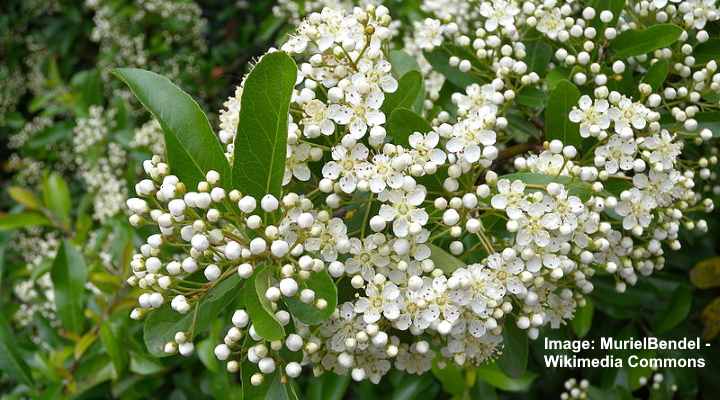
Scarlet firethorn flowers
Scarlet firethorn shrub red-orange berries grow 0.25” (6 mm) across. Its dense, impenetrable, spiny branches and foliage make it ideal as a privacy screen or security barrier. Its sprawling growth is ideal for covering slopes or growing along a fence line or wall. It also works well to deter wildlife from entering gardens.
Scarlet firethorn shrubs are drought-tolerant once established and perform well in dry soil. The bright orange shrub berries attract birds, adding its appeal as a landscaping shrub for wildlife gardens.
- USDA Planting Zones: 6 to 9
- Sunlight: Full sun to partial shade
- Mature Size: 6 to 12 ft. (1.8 – 3.6 m) tall and wide
Himalayan Firethorn (Pyracantha crenulata)

Himalayan firethorn—also called Nepalese firethorn—is identified by its deep orange-red or vibrant red berries. The thorny bush features oval, lanceolate leaves, sharp spines on its branches, and clusters of small, white, spring-blooming flowers. Depending on the conditions, berry-like pomes or tiny apples can be orange, red, or yellow.
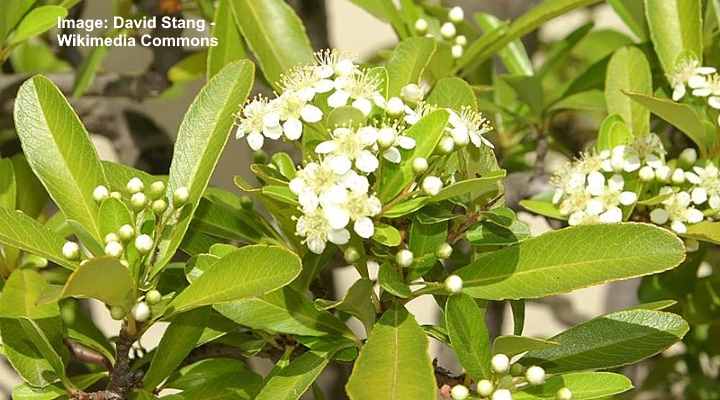
Close up picture of Himalayan firethorn flowers and leaves
Himalayan firethorn is an orange-fruit-producing shrub that doesn’t grow taller than 10 ft. (3 m) tall. The dark green leaves measure up to 1.6” (4 cm) long, and its berries are 0.2” to 0.35” (5 – 9 mm) long. Each berry contains three or four triangular-shaped seeds.
With its vibrant berries and year-round greenery, Himalayan firethorn adds beauty and interest to any garden or landscape. However, it’s good to note that the shrub can become invasive in some regions of North America.
- USDA Planting Zones: 6 to 9
- Sunlight: Full sun to partial shade
- Mature Size: 8 to 10 ft. (2.4 – 3 m) tall and wide
Sea Buckthorn (Hippophae rhamnoides)
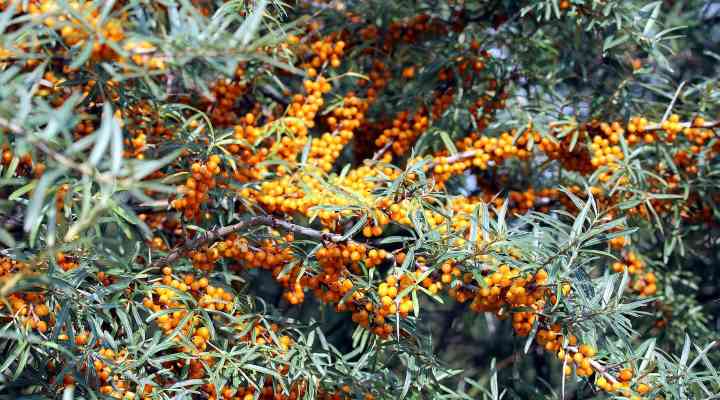
Sea buckthorn is a deciduous shrub with dense clusters of orange berries. This thorny shrub features mahogany brown or black bark, narrow, lanceolate silvery-green leaves, and tiny green petalless flowers followed by orange berry clusters. This cold-hardy shrub thrives in coastal regions, making it ideal for northern landscapes near the ocean.
Sea buckthorn grows up to 13 ft. (4 m) tall with an irregular crown. The spiny shrub has vigorous growth and edible orange berries. The bright orange color and grayish silvery leaves create an interesting landscape accent. It also tolerates a range of soil conditions, including poor and sandy soils.
Landscaping uses for common sea buckthorn include foundation planting, windbreaks, privacy screens, or soil erosion control. It’s also known for its nitrogen-fixing ability to improve soil quality.
- USDA Planting Zone: 3 to 7
- Sunlight: Full sun
- Mature Size: 5 – 13 ft. (2 to 4 m) tall and wide
American Bittersweet (Celastrus scandens)

American bittersweet is a fast-growing deciduous vine with showy orange berries appearing in the fall. Identifying features of this woody vine are its finely serrated dark green leaves that turn yellow in the fall, small greenish-yellow flowers blooming in spring and summer, and orange-yellow berries.
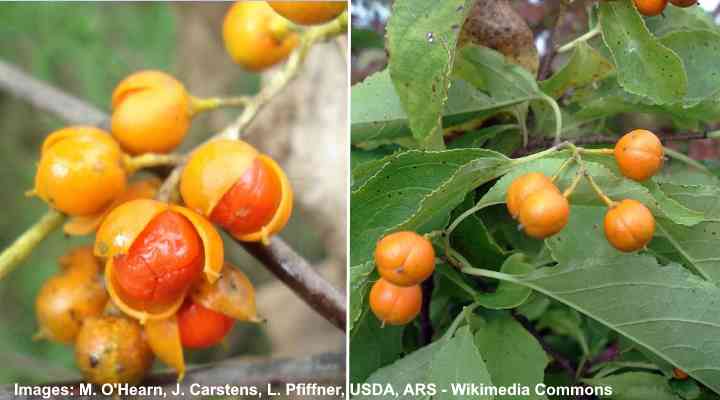
Close up image of American bittersweet orange berries
The inedible orange-yellow berries of American bittersweet brighten fall and winter landscapes. Thriving in full sun or dappled shade, the shrub grows up to 20 ft. (6 m) tall. When the round orange fruits split, scarlet seeds fall to the ground.
This drought-tolerant, deer-resistant shrub thrives in various soil types, including clay, sand, or loam. It’s a good landscaping option as a woody ground cover. The woody vine also performs well growing over fences, trellises, arbors, and walls. It’s an easy-grow vining shrub that requires minimal pruning.
- USDA Planting Zones: 3 to 8
- Sunlight: Full sun
- Mature Size: 15 to 20 ft. (4.5 – 6 m) long and 3 to 6 ft. (0.9 – 1.8 m) wide
Winterberry (Ilex verticillata ‘Winter Gold’)

Winterberry ‘Winter Gold’ cultivar is a multi-stemmed deciduous shrub with clusters of golden orange berries. This variety of holly is known for its dark green leaves that turn golden-bronze in the fall. The orange-fruiting shrub also has clusters of spring-blooming greenish-white flowers. These are followed by abundant clusters of orange berries in the fall that persist throughout the winter.
Winterberry ‘Winter Gold’ grows up to 8 ft. (2.4 m) tall. It’s easy to grow in full sun and moist soils with excellent drainage. The shrub performs well in mixed shrub borders or growing as a foundation planting, hedge, or in rain gardens. The bright golden berries of winterberry’ Winter Gold’ create a stunning contrast against the bare winter landscape.
If you are looking for a smaller winterberry shrub with orange berries, you can choose winterberry ‘Little Goblin Orange’ which grows only 3 -4 ft. (0.9 – 1.2 m) tall and wide.
- USDA Planting Zone: 3 to 9
- Sunlight: Full sun to partial shade
- Mature Size: 5 to 8 ft. (1.5 – 2.4 m) tall and wide
Orange-Fruited Whitebeam (Sorbus croceocarpa)

Orange-fruited whitebeam is a deciduous large shrub or tree producing clusters of vibrant orange berries. In the spring, creamy white flowers bloom. This large shrub with orange berries features oval or egg-shaped leaves with serrated margins that turn vibrant orange-red shades in the fall. This medium-sized tree can grow up to 30 ft. (9 m) tall.
The orange-fruited whitebeam is ideal for adding color and interest to gardens and landscapes. The shrub-like tree is also resistant to disease and pollution, making it a hardy and low-maintenance tree. It’s useful as a shade tree in parks and landscapes. The orange berries attract birds and wildlife, adding to the tree’s appeal.
- USDA Planting Zone: 3 to 7
- Sunlight: Full sun
- Mature Size: 20 to 30 ft. (6 – 9 m) tall
Whitebeam ‘Lutescens’ (Sorbus aria ‘Lutescens’)

Whitebeam ‘Lutescens’ is a medium-sized deciduous tree with attractive green-gray foliage and bright orange-red berries. This ornamental tree features oval-shaped silvery gray leaves and flat-topped clusters of white flowers followed by small orange fruits. The tree’s foliage turns an eye-catching yellow to russet in the fall.
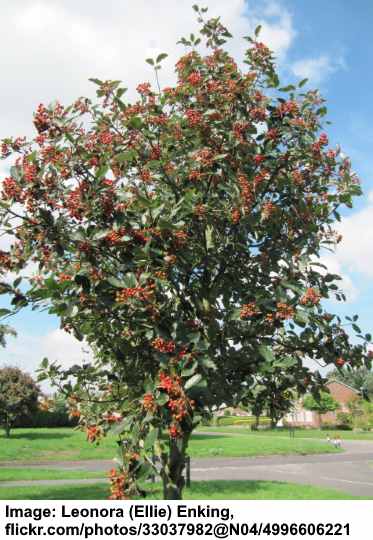
Whitebeam ‘Lutescens’ tree
Whitebeam ‘Lutescens’ grows up to 30 ft. (9 m) tall and has a broad pyramidal crown. The versatile tree thrives in full sun or partial shade in moderately fertile, humus-rich soils. Its elegant flowers, showy orange berries, and attractive silvery foliage add visual appeal from spring through fall.
- USDA Planting Zone: 4 to 7
- Sunlight: Full sun to partial shade
- Mature Size: 25 to 30 ft. (7.6 – 9 m) tall and up to 25 ft. (7.6 m) wide
Rowan or European Mountain Ash (Sorbus aucuparia)

European mountain ash is a medium sized deciduous tree or large shrub with clusters of showy bright orange-red berries. Identifying features of the tree are its dark green, pinnate leaves, masses of flat-topped clusters of white flowers, and abundant bunches of orange berry-like pomes. In the fall, its foliage turns red and reddish-purple.
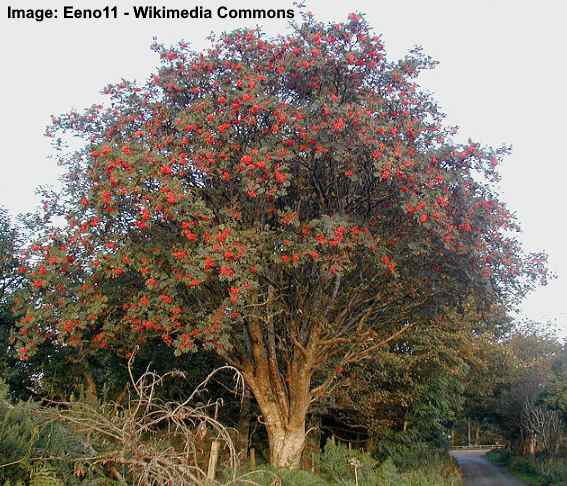
European mountain ash tree
Also called a rowan tree, the plant can grow up to 40 ft. (12 m) tall. It’s characterized by its rounded or oval-shaped crown. Rowan trees are widespread throughout Northern Europe. Landscaping uses for rowan trees include their ornamental value, use as a shade tree, and for attracting wildlife.
The attractive ornamental tree has aesthetic value in any season.
- USDA Planting Zone: 3 to 6
- Sunlight: Full sun to partial shade
- Mature Size: 20 to 40 ft. (6 to 12 m) tall and 8 to 20 ft. (2.4 – 6 m) wide
Franchet’s Cotoneaster or Orange Cotoneaster (Cotoneaster franchetii)

Franchet’s cotoneaster is a deciduous shrub with vibrant orange-reddish berries that add a burst of color to landscapes. This semi-evergreen bushy plant features glossy, lance-shaped leaves that turn yellow with red streaks in the fall. Its flowers are tiny, pink and white five-petaled blooms appearing on arching branches in early summer.
Franchet’s cotoneaster grows up to 10 ft. (3 m) tall. Its elliptic to oval leaves measure 1.5” (3.8 cm) long, and its attractive bright orange berry-like pomes are 0.25” (6.3 mm) in diameter. The foliage remains evergreen in warmer regions, but the leaves drop in the fall in colder climates.
The berries on orange cotoneaster shrubs provide food for birds and add visual interest to the shrub throughout the fall season. However, they are poisonous to humans. Landscaping uses for the plant are informal hedges, foundation planting, screens, or as a standalone accent plant.
- USDA Planting Zone: 6 to 9
- Sunlight: Full sun to partial shade
- Mature Size: 6 to 10 ft. (1.8 – 3 m) tall and 4 to 8 ft. (1.2 – 2.4 m) wide
Pindo Palm Fruit – Jelly Palm Fruit (Butia capitata)
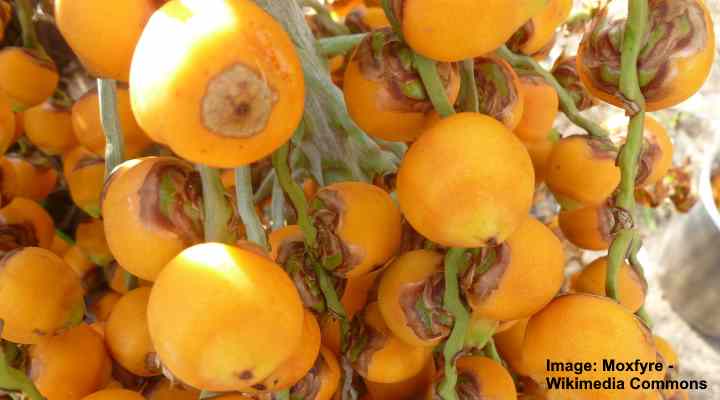
Pindo palm fruit
The Pindo palm is a small to medium-sized palm tree that produces large orange-yellow fruit. Also called the jelly palm, the tree is recognizable by its feathery, arching fronds up to 6 ft. (1.8 m) long. The palm leaves have up to 60 pairs of leaflets. Clusters of small, creamy-yellow flowers appear in summer, followed by bunches of abundant orange date-like fruits.
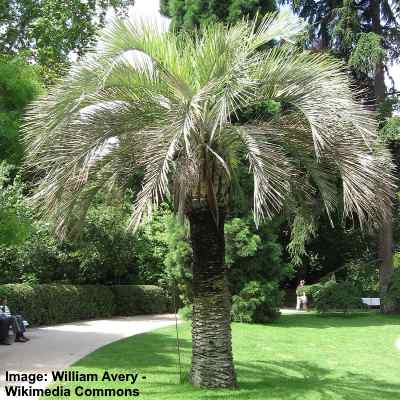
Pindo palm tree
The Pindo palm tree grows up to 20 feet (6 m) tall. Its solitary trunk has a jagged appearance from old fronds that have broken off. Its foliage is blue-green or grayish-green, adding a tropical touch to garden landscapes. The hardy palm tolerates drought, heat, and salt and is one of the hardiest palms.
The Pindo palm is a versatile tree ideal as a focal point in a tropical or Mediterranean garden. Its tolerance to salt spray and windy conditions means it’s a good landscaping palm in coastal areas.
- USDA Planting Zone: 9 to 11
- Sunlight: Full sun or partial shade
- Mature Size: 10 to 20 ft. (3 – 6 m) tall and 10 to 15 ft. (3 – 4.5 m) wide
Cape Gooseberry (Physalis peruviana)
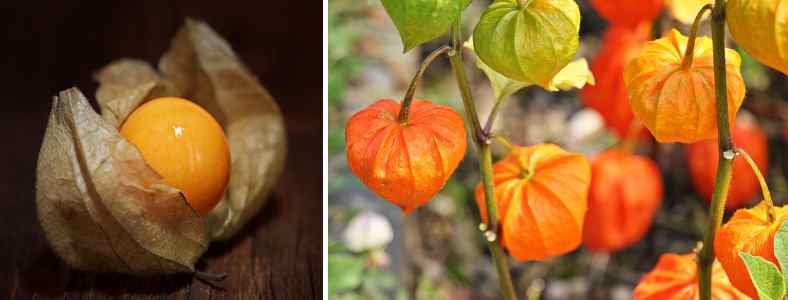
Cape gooseberry is a small shrub in the nightshade family producing sweet, bright orange berries in a papery husk. The heat-loving bushy plant features heart-shaped leaves, bell-shaped, creamy-yellow drooping flowers, and colorful orange berries. The round orange fruits are rich in vitamin C and resemble miniature lanterns before the papery husk opens.

Cape gooseberry shrub
Cape gooseberry grows up to 5 ft. (1.5 m) tall and thrives in full sun and well-drained soil. This compact, easy-to-grow shrub is well-suited for small gardens or containers. Apart from their decorative appeal, the papery husk helps preserve the orange fruits for several months after picking.
This shrub is a popular choice for ornamental fruit gardens. Its compact growth makes it ideal for planting in borders, beds, or containers. Its hanging husks and velvety foliage create an interesting appearance in garden landscapes.
The edible yellow to orange berries are also a delightful addition to fruit salads, desserts, or jams. Cape gooseberry is rich in vitamins and antioxidants, making the shrub’s fruit a healthy addition to any diet.
- USDA Planting Zone: 8 to 11
- Sunlight: Full sun to partial shade
- Mature Size: 2 to 3 ft. (0.6 – 0.9 m) tall and wide
Related articles:
